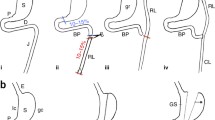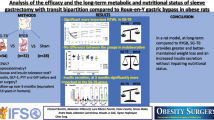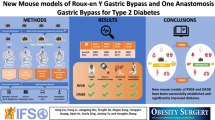Abstract
Obesity affects 30% of the United States population and its detrimental effects are obesity-related metabolic diseases. For patients refractory to conventional weight loss therapy, gastric bypass surgery is one of the proven methods for inducing a sustained weight loss and reversing the metabolic sequelae of obesity. To understand the mechanisms of weight loss and the amelioration of related metabolic comorbid conditions, a reproducible animal model is needed. We report our developmental experience with rat models of sequential Roux-en-Y gastric bypass after reproducing the diet-induced obesity that characterizes the hallmarks of human obesity. Four experiments were performed to induce weight reduction through successive modifications: In Experiment 1 a 20% stapled gastric pouch with a 16 cm biliarypancreatic limb and a 10 cm alimentary limb accomplished sufficient weight loss within 10 days to ameliorate metabolic changes associated with obesity, but the occurrence of gastrogastric fistulas prevented sustained weight loss; in Experiment 2 the model was improved by dividing the stomach to avoid gastrogastric fistula, but again sustained weight loss was not achieved; in Experiment 3 the biliarypancreatic limb was lengthened from 16 to 30 cm, reducing the common channel to approximately 18 cm. Sustained weight loss was achieved for 28 days. In Experiment 4 the model in Experiment 3 was modified by dividing the stomach between two rows of staples. Sustained weight loss was observed for 67 days. We developed a reproducible rat model of Roux-en-Y gastric bypass. The existence of this model opens a new field of research in which to study the metabolic sequelae of obesity and the mechanisms of weight loss.
Similar content being viewed by others
References
Banting FG, Best CH. Pancreatic extracts. 1922. J Lab Clin Med 1990;115:254–272.
Dudrick SJ, Wilmore DW, Vars HM, Rhoads JE. Long-term total parenteral nutrition with growth, development, and positive nitrogen balance. Surgery 1968;64:134–142.
Stevens F, Truesdale KP. Epidemiology and consequences of obesity. J GASTROINTEST SURG 2003;7:438–442.
Flegal K, Carroll M, Odgen CL, Johnson CL. Prevalence and trends in obesity among US adults, 1999–2000. JAMA 2002;288:1723–1727.
O’Brien PE, Dixon JB. The extent of the problem of obesity. Am J of Surg 2002;184:S4-S8.
Brolin RE. Bariatric surgery and long-term control of morbid obesity. JAMA 2002;288:2793–2796.
Reaven GM. Role of insulin resistance in human disease (syndrome X): An expanded definition. Annu Rev Med 1993;44:121–131.
Abu-Abid S, Szold A, Klausner J. Obesity and cancer. J Med 2002;33:73–86.
Field AE, Coakley EH, Must A, Spadano JL, Laird N, Dietz WH, Rimm E, Colditz GA. Impact of overweight on the risk of developing common chronic diseases during a 10-year period. Arch Intern Med 2001;161:1581–1586.
Deitel M. How much weight loss is sufficient to overcome major comorbidities. Obes Surg 2001;11:659.
Jequier E. Is fat intake a risk factor for fat gain in children? Clin Endocrinol Metab 2001;86:980–983.
Kaplan LM. Body weight regulation and obesity. J GASTROINTESTINAL SURG 2003;7:443–451.
Schauer PR. Open and laparoscopic surgical modalities for the management of obesity. J GASTROINTESTINAL SURG 2003; 7:468–475.
Fisher BL, Schauer P. Medical and surgical options in the treatment of severe obesity. Am J Surg 2002;184:9S-16S.
Pories WJ, Swanson MS, MacDonald KG, Long SB, Morris PG, Brown BM, Barakat HA, de Ramon RA, Israel G, Dolezal JM. Who would have thought it? An operation proves to be the most effective therapy for adult-onset diabetes mellitus. Ann Surg 1995;222:339–350.
Ramos EJB, Xu Y, Middleton F, Chen C, Quinn R, Inui A, Das UN, Meguid MM. Is obesity an infiammatory disease? Surgery 2003;134:329–335.
Cottam DR, Mattar SG, Schauer PR. Laparoscopic era of operations for morbid obesity. Arch Surg 2003;138:367–375.
Levin BE, Dunn-Meynell AA, Routh VH. Brain glucose sensing and body energy homeostasis: Role in obesity and diabetes. Am J Physiol 1999;76:R1223-R1231.
Xu Y, Ohinata K, Meguid MM, Marx W, Tada T, Chen C, QuinnR, Inui A. Gastric bypass model in the obese rat to study metabolic mechanisms of weight loss. J Surg Res 2002;107:56–63.
Nguyen NT, Goldman C, Rosenquist CJ, Arango A, Cole CJ, Lee SJ, Wolfe BM. Laparoscopic versus open gastric bypass: A randomized study of outcomes, quality of life, and costs. Ann Surg 2001;234:279–289.
Barrow CJ. Roux-en-Y gastric bypass for morbid obesity. AORN J 2002;76:593–604.
Laviano A, Meguid MM. Serotonin and obesity. Curr Med Chem-Central Nervous System Agents 2003;3:89–100.
Friedman JM, Halaas JL. Leptin and the regulation of body weight in mammals. Nature 1998;395:763–770.
Romanova R, Ramos EJB, Xu Y, Middleton F, Chen C, Ugrumov M, Inui A, Meguid MM. The balance between hypothalamic orexigenic and anorexigenic modulators after gastric bypass. J Am Coll Surg 2003;197:S43.
Author information
Authors and Affiliations
Additional information
Supported in part by the Hendrick’s Fund, grant NIH/DK 003568, by an educational grant from the Department of Surgery, Upstate Medical University, and by grants from Ethicon, Cincinnati, Ohio.
Rights and permissions
About this article
Cite this article
Meguid, M.M., Ramos, E.J.B., Suzuki, S. et al. A surgical rat model of human Roux-en-Y gastric bypass. J Gastrointest Surg 8, 621–630 (2004). https://doi.org/10.1016/j.gassur.2004.02.003
Issue Date:
DOI: https://doi.org/10.1016/j.gassur.2004.02.003




